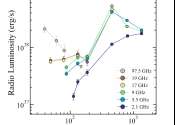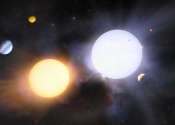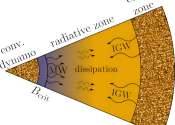Last update:
Astronomy & Space news

Citizen scientists help discover record-breaking exoplanet in binary star system
A team of astronomers and citizen scientists has discovered a planet in the habitable zone of an unusual star system, including two stars and potentially another exoplanet.
Astronomy
12 hours ago
0
147

Researchers explore an old galactic open cluster
Using data from ESA's Gaia satellite, astronomers from Turkey and India have investigated NGC 188—an old open cluster in the Milky Way. Results of the study, published April 19 on the pre-print server arXiv, deliver important ...

New observatory in Chile—the highest in the world—aims to reveal origins of planets, galaxies and more
How do planets form? How do galaxies evolve? And ultimately, how did the universe itself begin? A unique astronomical observatory that researchers hope will unravel some of the biggest mysteries out there marks its opening ...
Astronomy
4 hours ago
0
50

Novel calculations peg age of 'baby' asteroid
An asteroid dubbed "Lucy's baby" after a NASA spacecraft discovered it is orbiting another asteroid last November is,, in fact,, a solar system toddler—just 2–3 million years old, a Cornell-led research team estimates ...
Astronomy
12 hours ago
0
132

Clouds blanket the night side of the hot exoplanet WASP-43b
Using the James Webb Space Telescope (JWST), a team of astronomers, including scientists from MPIA, constructed a global temperature map of the hot, gas giant exoplanet WASP-43b. The nearby parent star perpetually illuminates ...
Astronomy
13 hours ago
0
26

Enceladus spills its guts through strike–slip motion
Over the course of its elliptical orbit, the moon Enceladus is squeezed unevenly by Saturn's gravitational pull and deforms from a spherical shape into a football shape and back again. This cyclic stress causes a phenomenon ...
Astrobiology
13 hours ago
0
15

Astronomers' simulations support dark matter theory
Computer simulations by astronomers support the idea that dark matter—matter that no one has yet directly detected but which many physicists think must be there to explain several aspects of the observable universe—exists, ...
Astronomy
14 hours ago
0
49

Launch date set for NASA's PREFIRE mission to study polar energy loss
NASA and Rocket Lab are targeting no earlier than Wednesday, May 22, 2024, for the first of two launches of the agency's PREFIRE (Polar Radiant Energy in the Far-InfraRed Experiment) mission to study heat loss to space in ...
Planetary Sciences
9 hours ago
0
18

JWST uses interferometry mode to reveal two protoplanets around a young star
The JWST is flexing its muscles with its interferometry mode. Researchers used it to study a well-known extrasolar system called PDS 70. The goal? To test the interferometry mode and see how it performs when observing a complex ...
Planetary Sciences
11 hours ago
0
6

Two new satellites join the Galileo constellation
The European Galileo navigation system has two more satellites in orbit following their launch in the early morning of Sunday, 28 April, at 01:34 BST/02:34 CEST. With 30 satellites now in orbit, Galileo is expanding its constellation, ...
Space Exploration
11 hours ago
0
1

NASA's Mars Sample Return mission is in trouble—but it's a vital step to sending humans to the red planet
NASA recently asked the scientific community to help come up with innovative ideas for ways to carry out its Mars Sample Return (MSR) mission. This was in response to a report by an independent board that deemed that its ...
Space Exploration
11 hours ago
0
1

Chinese astronauts return to earth after six months in space
China's Shenzhou-17 spacecraft returned to Earth Tuesday, carrying three astronauts who have completed a six-month mission aboard the country's orbiting space station.
Space Exploration
11 hours ago
0
8

Astronomers significantly impact the climate by traveling to conferences, say researchers
In 2019, global travel to international academic conferences in the field of astronomy caused the equivalent of 42,500 tons of climate-damaging CO2 emissions. This equates to an average of one ton of CO2 per participant and ...
Astronomy
11 hours ago
0
23

Tidal disruption event ASASSN-19bt experiences unusual radio evolution, observations show
An international team of astronomers has conducted detailed radio and X-ray observations of a tidal disruption event (TDE) designated ASASSN-19bt. Results of the observational campaign, presented April 18 on the pre-print ...

Webb captures iconic Horsehead Nebula in unprecedented detail
The NASA/ESA/CSA James Webb Space Telescope has captured the sharpest infrared images to date of one of the most distinctive objects in our skies, the Horsehead Nebula. These observations show a part of the iconic nebula ...
Astronomy
Apr 29, 2024
0
45

Revealing the origin of unexpected differences in giant binary stars
Using the Gemini South telescope a team of astronomers have confirmed for the first time that differences in binary stars' composition can originate from chemical variations in the cloud of stellar material from which they ...
Astronomy
Apr 29, 2024
0
98

Orion's erupting star system reveals its secrets
An unusual group of stars in the Orion constellation have revealed their secrets. FU Orionis, a double star system, first caught astronomers' attention in 1936 when the central star suddenly became 1,000 times brighter than ...
Astronomy
Apr 29, 2024
0
48

New study reveals mystery of decaying exoplanet orbits
A new study led by researchers at Durham University has uncovered a novel mechanism that could solve a long-standing mystery about decaying planetary orbits around stars like our sun.
Planetary Sciences
Apr 29, 2024
0
37

Probing the effects of interplanetary space on asteroid Ryugu
Analyzing samples retrieved from the asteroid Ryugu by the Japanese Space Agency's Hayabusa2 spacecraft has revealed new insights into the magnetic and physical bombardment environment of interplanetary space. The results ...
Planetary Sciences
Apr 29, 2024
0
8

NASA scientists gear up for solar storms at Mars
In the months ahead, two of NASA's Mars spacecraft will have an unprecedented opportunity to study how solar flares—giant explosions on the sun's surface—could affect robots and future astronauts on the Red Planet.
Planetary Sciences
Apr 29, 2024
0
8
More news

SpaceX lines up pair of Space Coast launches for the weekend

China's Shenzhou-18 mission docks with space station

TESS finds its first rogue planet
Other news

Study uncovers the secret of long-lived stem cells

Biodegradable 'living plastic' houses bacterial spores that help it break down

NASA astronauts arrive for Boeing's first human spaceflight

Hera asteroid mission's side-trip to Mars

Signs of 'spider' phenomenon on Mars

Lunar landforms indicate geologically recent seismic activity on the moon

Researchers find oldest undisputed evidence of Earth's magnetic field

A virus could help save billions of gallons of wastewater produced by fracking
















































